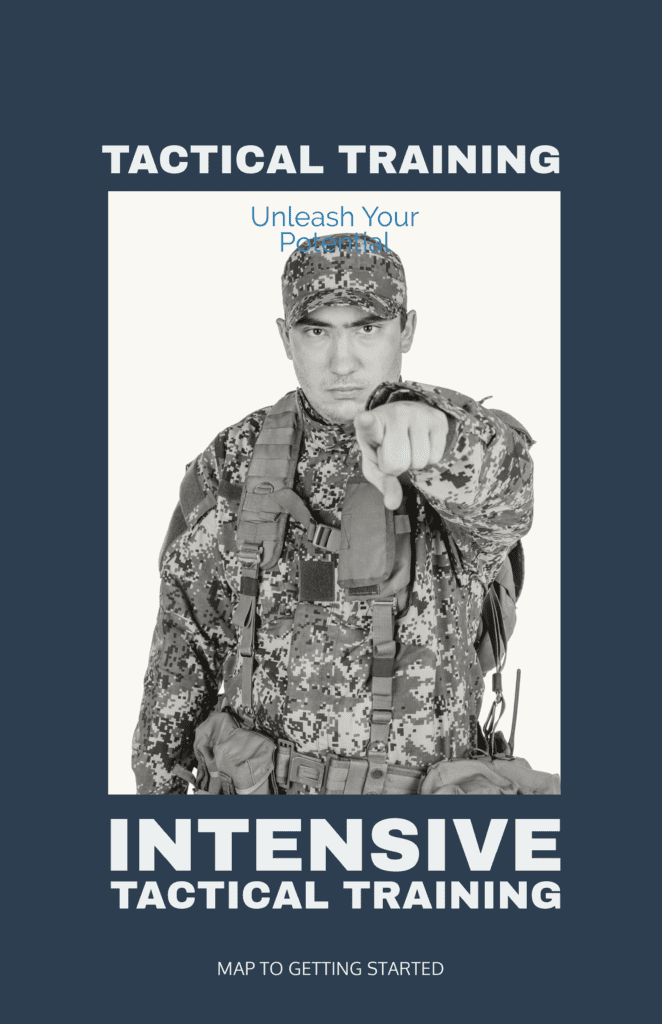Introduction

You’ve been exercising at the gym, using weights, and perhaps even running short distances intermittently. That’s fantastic, but let’s be honest for a minute. When was the last time you needed to bench press your way through a challenging circumstance? Rarely can bicep curls alone cure life’s problems. Tactical training can help with it.
Anyone who wants to be ready for the curveballs life throws their way should participate in tactical training; it is not just for elite military units or first responders. Tactical training can be your secret weapon, whether you’re a busy professional, a parent, or someone who already excels in some areas of life but wants to advance in others.
Why, therefore, should you think about including tactical training in your “whole life” experience? Because agility, endurance, and mental toughness are equally as important as physical strength. One step at a time, “Progress Not Perfection” is what’s meant.
Tactical training: What is it?
Let’s get through the lingo. A comprehensive approach to fitness known as tactical training gets you ready for difficulties in the real world. Being adaptive, inventive, and resilient is more important than just being able to move heavy objects or sprint quickly. Consider it your comprehensive toolkit for dealing with the unpredictabilities of life.

Tactical training has been refined from military and law enforcement training programs to help you perform well in a range of circumstances. You become a more well-rounded person as a result of the integration of essential elements like strength, agility, endurance, and mental toughness.
How does it differ from your typical gym routine, then? Individual muscle groups or particular athletic abilities are frequently the focus of traditional exercise. On the other hand, tactical training focuses on the larger picture. It involves combining different abilities and physical skills so you’re ready for anything, whether climbing a flight of stairs while carrying groceries or responding fast to an emergency.
The Importance of Tactical Training
Why should I care, you might be thinking? Let’s put it this way, shall we? The course of life is not prewritten. The next thing you know, you’re travelling through difficult terrain because you made the wrong way while out on a nice trip. Or perhaps you’re a mom who has to have the endurance to keep up with your active children and the power to lift them when they’re exhausted. Tactical training shines under these circumstances.
However, it goes beyond those hypothetical situations. Training in tactics is a fantastic fit for the “Progress Not Perfection” guiding principle. It’s meant to challenge you, but not to throw you off a cliff. Every session is a step in the direction of becoming a stronger, more capable version of yourself, intellectually and physically.
And, let’s be honest, how about that feeling of assurance that comes from thinking you can handle practically anything? That is invaluable. It has a domino impact on other aspects of your life, improving your capacity as a parent, leader, and resilient person.
The Elements of Tactical Education
Okay, let’s get down to business. The Swiss Army knife of your body and mind is tactical training. It has many facets, and each element has a specific function. The summary is as follows:
Physical: Strength, Speed, and Agility
Strength: This is about functional strength, not just the ability to lift big objects. Consider helping a friend move, lifting your children, or carrying groceries.
Speed: Have you ever had to run through an airport or catch a bus? You can go where you need to go more quickly with speed training.
Agility: Both literally and figuratively, life is full of turns and twists. When avoiding obstacles or making split-second judgments, agility training prepares you for fast changes in direction.
Mental: Stress management and decision-making
Decision-making: Quick-thinking situations are frequently used in tactical training. It’s similar to chess, but harder.
Stress Management: Let’s face it, life can be tough. Stress management. Your ability to remain composed under pressure is something you learn in tactical training.
There you have it, then. Tactical training is a curriculum for life, not just an exercise.
What to Do First
You now fully support the concept of tactical training. Awesome! But how do you get started? Don’t worry, you can get started without enlisting in the military or joining a SWAT squad. As a starting point, consider this route map:

Evaluate your current level of fitness
It’s critical to understand your position before getting started. You might be a gym rat, or you might not have worked out in a long time. In either case, knowing your baseline will help you customize your training.
Set reachable objectives
The motto of tactical training is “Progress Not Perfection.” Make sure your objectives are both difficult and doable. A tactical athlete is not created in a day, just as Rome wasn’t.
The Benefits of Specialized Coaching
Here, having a coach like me can make all the difference. With more than 20 years of coaching expertise and numerous certifications, I can offer you a tactical training program that is specifically tailored to meet your needs and objectives. Trust me, having individualized advice may radically alter your journey.
Find the Best Coach or Program
Look for a program or coach who resonates with your goals and way of life, even if you’re not working with me. A one-size-fits-all strategy won’t work given your particular needs. You require a personalized solution.
Start Little
You don’t have to act like a Navy SEAL right away. Increase the intensity gradually after starting with simple workouts. The key is consistency.
Follow Your Development
Keep a journal of your exercises, new skills, and accomplishments. This will help you adjust your regimen as necessary and keep you motivated.
Honour the victories
Achieved a new personal best? mastered that difficult manoeuvre? Enjoy the time of celebration. These little wins pile up and motivate you on your path to becoming a tactical athlete.
So there you have it—a guide to getting started with tactical training. Are you prepared to jump in?
Case Studies
Considering whether tactical training is more than simply marketing speak, Let’s have a look at some actual conversions that demonstrate its efficacy.
The Mobile Entrepreneur
Before: Alex, the founder of a startup, frequently travelled for business meetings and struggled to stick to a regular exercise schedule.
After: Alex discovered he could easily fit quick, fruitful exercises into his busy schedule after committing to a 12-week tactical training course. During crucial business conversations, he felt more focused, and his energy levels increased.
Outside Enthusiast
Before: Lisa, who adores kayaking and camping, thought she lacked the strength and abilities necessary to take full advantage of her outdoor pursuits.
After: Only two months of tactical training, Lisa had grown stronger and gained more confidence in her outdoor pursuits. Her outdoor activities improved and became less stressful.
The Committed Father
Before: Tom, a stay-at-home father, was having trouble keeping up with his energetic children and handling domestic duties.
After: Tom discovered he had more energy and was better prepared to face the physical and mental demands of parenthood six weeks into his tactical training journey. Even more, he made teaching his children some fundamental tactical abilities a family activity.
These narratives demonstrate how tactical training has a transforming effect. It’s not just about becoming in shape; it’s about improving your whole life, one strategic step at a time.
Misconceptions of Tactical Training

Let’s address some of the misunderstandings and fallacies that are frequently associated with tactical training now. Since there is a lot of false information out there, let’s face it.
“Only Military or Police Personnel May Use it.”
Reality: Everyone benefits from tactical training. The skills and fitness levels you’ll acquire are useful to everyone, regardless of age (student, retiree, or anywhere in between).
“It’s Too Difficult for the Average Person”
Reality: Recall the phrase we live by: “Progress, not perfection”? You can scale tactical training to meet you where you are. To begin, you don’t need to be athletic; all you need is the willingness to give it a shot.
“It’s hazardous.”
Reality: Although there is some risk associated with every exercise, tactical training is made to be as safe as possible. Additionally, having a qualified coach (hint, wink) might help to ensure that you are performing exercises safely.
“It is merely a fad.“
Reality: Military and law enforcement organizations have perfected tactical training over many years. It has endured because it is effective.
We want to make tactical training more approachable and less frightening by busting these fallacies. Anyone who is willing to invest in their “whole life experience” can profit from this instrument.
Conclusion
So there you go, everyone. Tactical training is not a secret society or an impassable mountain. It’s a realistic, flexible, and very effective strategy to get ready for the difficulties that life will present you with. It’s a thorough plan that perfectly embodies the “Progress Not Perfection” philosophy by placing equal focus on mental and physical toughness.
If you’re an entrepreneur, a parent, or someone who is currently successful in certain aspects but seeking to grow in others, tactical training can be your secret weapon. Remember that you don’t have to go it alone as well. A trained coach can provide invaluable counsel and design a program that is specifically catered to your needs.
Do you have the wherewithal to invest in your “whole life” experience? You will start by making a decision.
Take the risk. You’ll be grateful to your future self.


